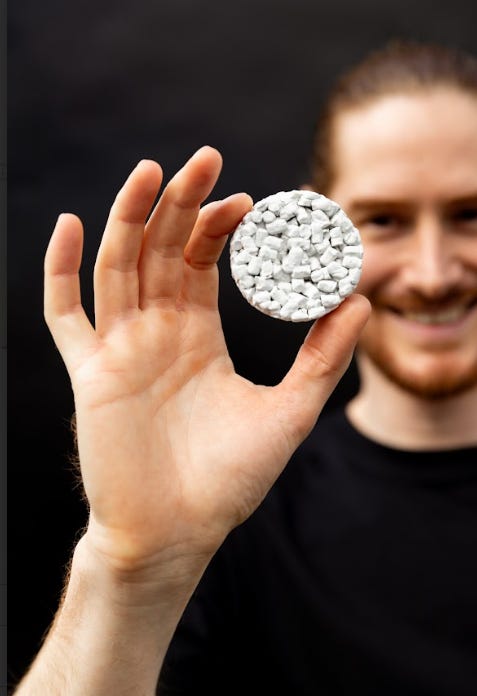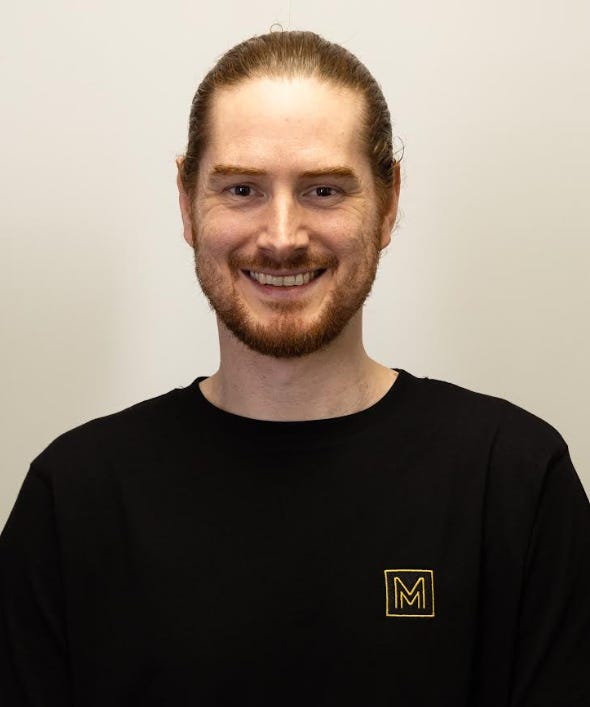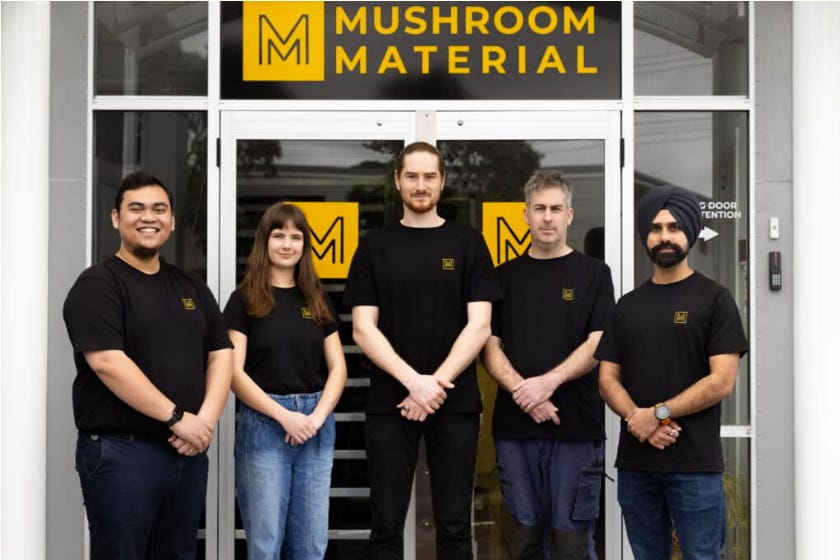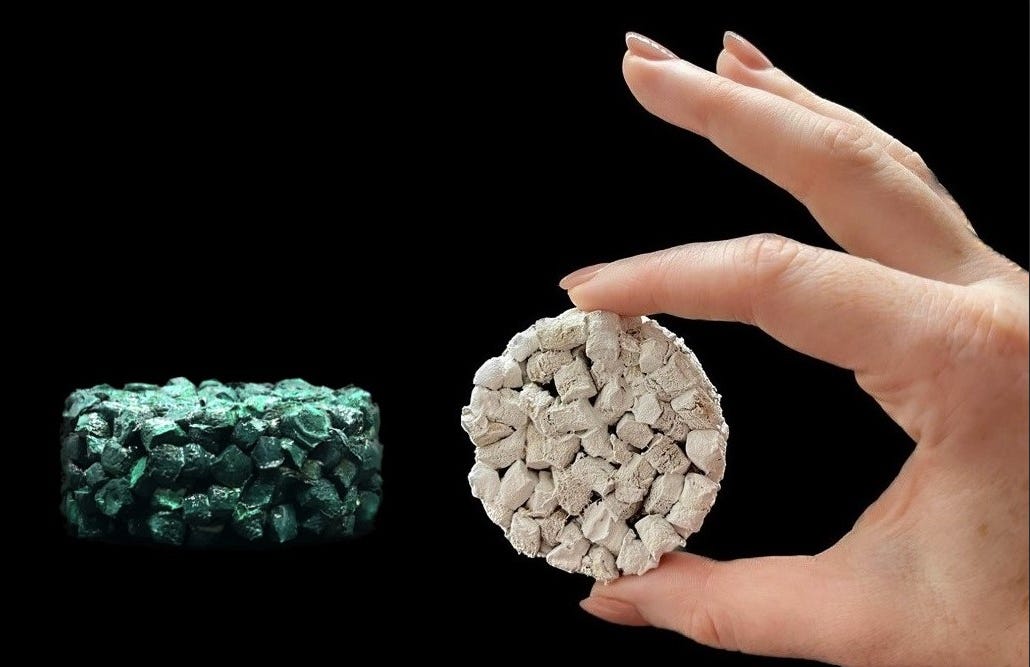This packaging startup wants to replace styrofoam with mushrooms🍄
They've created an eco-friendly alternative to polystyrene using mycelium and agricultural waste
A few weeks ago, we sat down with Shaun Seaman, the founder of Mushroom Material, a sustainable packaging startup using fungi to create an eco-friendly alternative to styrofoam.
Founded in 2020, the startup has developed a sustainable, fungi-based material that could transform the packaging industry. We asked him a few questions about his mycelium packaging innovation, his entrepreneurial journey and his thoughts on the future of sustainable packaging.
Curious to find out more about Shaun and his startup journey? Read on!
Startup Spotlight: Mushroom Material, New Zealand
From their base in Auckland, New Zealand, Mushroom Material is working on an eco-friendly replacement for styrofoam. It’s customisable, impact-absorbing, and fully home-compostable.
Shaun and his team believe they’ve created a 1-to-1 substitute that can handle everything styrofoam can — including the weight of heavy electronics.
“From production to end of life, styrofoam is just awful for the environment,” Shaun explains. “It doesn’t biodegrade, breaks down into microplastics, and leaches chemicals into our food and water. We knew there had to be a better way.”
But Shaun’s journey didn’t begin in sustainability…
Shifting Gears: From Mechanical Engineering to Mushrooms
Born in South Africa, raised in Dubai, and now living in New Zealand, Shaun pursued his studies in mechanical engineering.
After graduating, he worked across companies big and small, from designing washing machine parts at New Zealand’s largest appliance manufacturer to dabbling in intellectual property.
But entrepreneurship was always the dream.
His first venture was a travel app, which earned him a spot at the Entrepreneur First incubator. Fun as it was, he soon realised travel tech wasn’t his true calling.
During this time, Shaun took a trip to Indonesia that completely shifted his perspective.
“I went on a surf trip to Indonesia thinking I would get to see beautiful pristine blue waters and sandy beaches. Instead I was greeted with rubbish everywhere. Plastic bags in the ocean, styrofoam covering the beaches… it was a real moment of reckoning for me. I couldn’t stop thinking, we are really screwing up the planet. And I couldn’t just sit with that.”
That trip was the turning point. Shaun realised that if he wanted to see change, he had to be part of it and make it happen.
And thus began his journey with Mushroom Material.
But Why Mushrooms? 🍄
Back in New Zealand, Shaun began talking to microbiologists and material scientists — connections from his time at Entrepreneur First. He was fascinated with fungi and its potential as a packaging material.
He went down a rabbit hole of research, learning all he could about packaging and the world of fungi. His studies revealed that a 1-1 packaging replacement was possible.
He learned that mycelium could be a powerful, natural substitute for plastic. It could grow into any shape, hold any weight, and return to the earth after use.
He was convinced to put all his focus on fungi. This is also where being a mechanical engineer turned out to be a blessing in disguise.
“As engineers, we had no idea what wasn’t possible,” Shaun laughs. “We weren’t limited by any preconceived notions. That worked in our favour. We came in thinking anything is possible… because we didn’t know if it's not! That was really why we were able to palletise the material and take a completely new approach. And thankfully, it worked!”
From here on, things moved quickly.
Reimagining Packaging from the Ground Up
The team started with a simple process: mixing organic agricultural waste with mycelium and letting it grow into moulded shapes.
But there was a catch: it took two weeks for the material to grow. Scaling that to industrial levels? Not so easy.
“If someone wants 100,000 cup protectors, we’d need 100,000 moulds. It’s not practical… it takes up space, time, and money. Plus, if you want to tweak the design, you’d have to redo everything.”
So, Shaun asked a simple question: What if we could pelletise it like plastic?
He realised that plastic injection moulds already exist in the market. These are used to apply heat and pressure to plastic pellets to form desired shapes. So why not pelletise their product?
By turning their material into pellets, they could tap into existing infrastructure like plastic injection moulding. Just like plastic pellets, these can be pressed and shaped into an injection mould to produce desired shapes.
Same process, but with sustainable materials.
And it worked!
The resulting material was elastic, impact-resistant, and could be moulded into any shape — over and over and over again.
The beauty of the final product is how quickly it could bounce back to its original shape. The repeated impact provided good shock absorption.
After multiple trials and errors, the company successfully developed different prototypes.
The Path to Product
For the first 3.5 years, the company was all about R&D. The team, a tight group of engineers, obsessed over scale and cost.
“We want to be the new styrofoam. And to do that, we need to hit volume and drop the price. That’s the only way.”
Shaun estimates they’ve gone through 400 iterations of the product.
“Some weeks we were doing 10 to 20 tweaks. Constant testing, non-stop. How do we make it slightly better? Faster? Stronger? Cheaper? That’s been our mantra for four years.”
They now have a production line up and running. Although the team has discovered a way to scale, the biggest challenge right now is ramping up quickly — and finding the right customers to grow with them.
Funding, Feedback, & Fighting for Belief
From the beginning, reactions to the product were a mix of excitement and skepticism.
After all, Shaun isn’t the first to try mushroom-based packaging — and many past attempts fizzled out due to scale issues.
That made investor conversations tricky.
“Most talks started on a negative point,” he admits. “You’ve got to essentially fight to prove what you have from the very first sentence.”
Still, early momentum helped. Mushroom Material joined the TechStars Accelerator. Within 24 hours, they had secured their first investor. But raising more money wasn’t so straightforward.
“We pitched over 300 times. People said we were crazy. Others loved it but couldn’t lead the round. It came down to finding that one investor who truly understood what we were doing.”
Eventually, they did. Countless flying hours and over 300 pitches did the trick.
“I went from associate, to senior associate, to principal, to partner, and four conversations later, we had a term sheet. It all just clicked. Best partnership we could’ve asked for.”
Since then, the company has grown from a 3-person to 9-person team. They moved out of the garage and into a 1,600 sq m facility. Work began on the actual production line. They’ve raised $5.5 million USD to date and are already on their second funding round.
What’s Next: Going to Market & Scaling Across Europe
The team’s goal this year is to focus on launch.
“It’s been four years of R&D. By the end of this year, it’ll be five. We need to be in the market.”
Their goal in the next five years is to scale across multiple regions. And in ten? Becoming a household name. But the clock is ticking.
“Styrofoam has had an 80-year head start. We’re trying to replace it in 8. That means moving at 10X the speed.”
For Shaun, it has been an exciting journey so far. But he is aware of the challenges lying ahead. What keeps him going through it all is his passion for sustainability — and the people in it.







Inspired development + perseverance to achieve a really worthwhile goal. All the best!